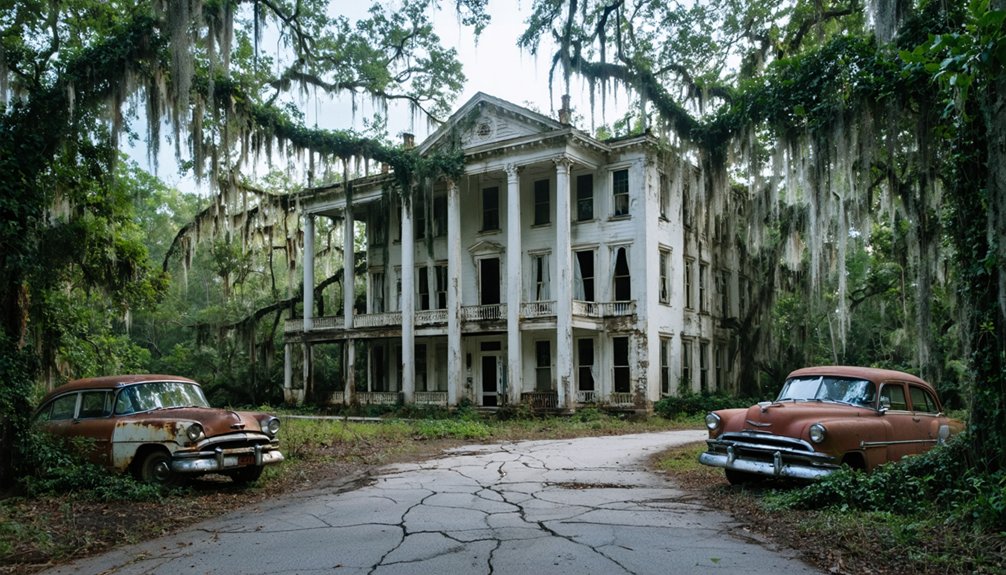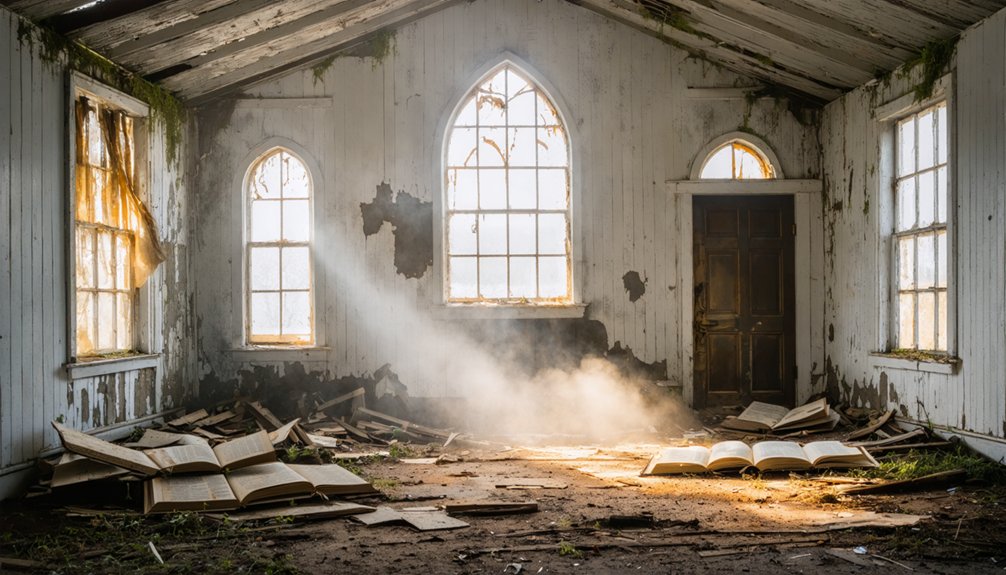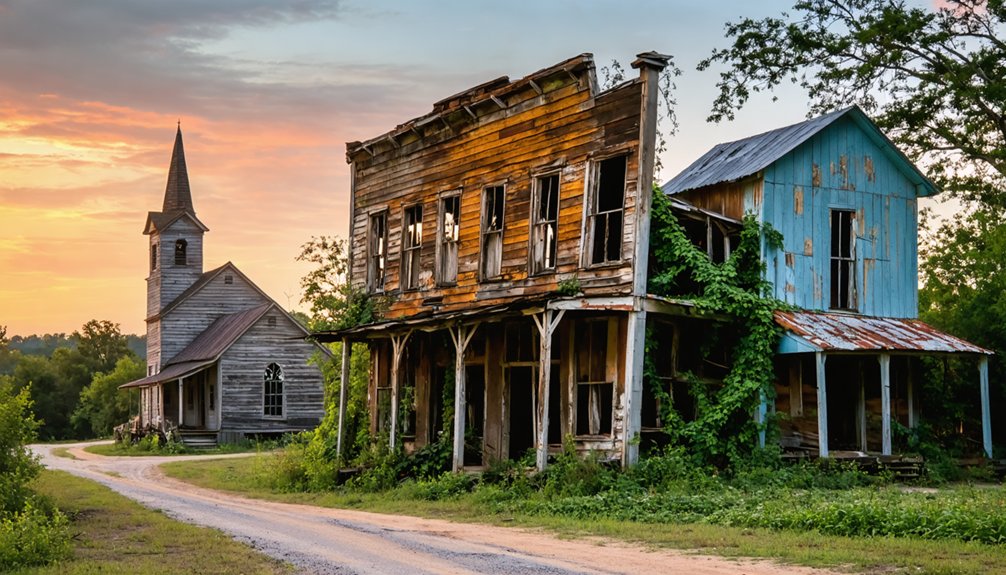Southern ghost towns reveal America’s forgotten past through their eerie remains. You’ll find abandoned copper boomtowns like Gleeson, Arizona, with its 1910 jail, and Alabama’s former capital Cahawba, known for paranormal orbs. Ecological disasters transformed Bombay Beach from paradise to wasteland, while places like Ruby harbor dark histories of murder. From phantom train sounds at Fairbank’s depot to submerged communities beneath Louisiana’s waters, these haunting settlements hold untold stories waiting beyond their decaying facades.
Key Takeaways
- Cahawba, Alabama, the state’s first capital, declined after government moved but gained paranormal notoriety with ghost sightings and mysterious orbs.
- Southern ghost towns like Gleeson and Ruby preserve haunting relics of their mining heydays, including jails where visitors report spectral encounters.
- Fairbank, Arizona manifests paranormal activity through phantom train sounds and shadowy apparitions of former merchants near its abandoned rail depot.
- Environmental disasters transformed Bombay Beach from thriving paradise to toxic ghost town with only 231 residents by 2020.
- Haaswood Cemetery near “Pearl City” is considered one of Louisiana’s most haunted sites with apparitions and unexplained sounds among overgrown graves.
Gleeson, Arizona: Where the Old Jail Still Stands Watch
As you drive along the dusty road toward what remains of Gleeson, Arizona, the stark concrete structure of the 1910 jail emerges from the landscape like a sentinel guarding memories of a bygone era.
This reinforced concrete fortress replaced an earlier system where prisoners were simply chained to an oak tree—a tree you can still visit today.
The Gleeson Jail survived the devastating 1912 fire that consumed much of the town and stands as the most intact remnant of this once-thriving copper boomtown.
Now restored as a museum, you’ll find historical artifacts and local memorabilia displayed in its two former cells.
During its heyday, the town’s population rose to 6,000 by 1918, making Gleeson a significant mining community in the region.
Originally called Turquoise until 1894, the town was renamed after John Gleeson discovered copper deposits in the area.
Visit on the first weekend of each month when local volunteers open the doors, sharing tales of notorious prisoners like Luther Price and the frontier justice that defined this wild outpost.
Cahawba, Alabama: The Ghostly Orbs of a Former State Capital
Unlike the rugged jail of Gleeson that still physically anchors its ghost town, Cahawba‘s spectral reputation emerges from what’s largely vanished.
Founded in 1819 at the confluence of two rivers, this first Alabama capital thrived briefly before political decisions moved government operations to Tuscaloosa in 1826. Cahawba history reveals it wasn’t flooding that initially drove residents away, as commonly believed, but rather the capital’s relocation.
The town experienced a renaissance as a cotton trade hub before Civil War disruption and subsequent flooding hastened its abandonment. During this period, an old cotton warehouse was converted into Kahaba Federal Prison, which held over 3,000 Union soldiers during the conflict. The mortality rate was relatively high, with approximately 142 to 147 deaths occurring during the prison’s operation due to disease and harsh conditions.
Today, as you explore Old Cahawba Archaeological Park, you might encounter the ghostly legends that define this hauntingly empty landscape.
Paranormal investigators document mysterious orbs near crumbling foundations where Greek Revival mansions once stood. These spectral phenomena, attributed to former residents and Civil War prisoners, transform archaeological ruins into portals to Alabama’s complex past.
Bombay Beach: A Salton Sea Resort Turned Apocalyptic Wasteland
At Bombay Beach, you’ll witness how a once-glittering 1950s resort paradise succumbed to an environmental catastrophe when agricultural runoff transformed the Salton Sea into a toxic, saline wasteland that destroyed infrastructure during the 1976-1977 floods.
The abandoned town’s post-apocalyptic landscape of rotting structures, empty streets, and the carcasses of dead fish presents a haunting reflection of humanity’s hubris in the face of ecological fragility.
Amid this decay, however, contemporary artists have reclaimed the ruins, transforming Bombay Beach into an unexpected open-air gallery where surreal installations stand in stark contrast against the poisoned shoreline, creating a jarring juxtaposition of creative rebirth within environmental devastation.
The town features numerous recycled art installations scattered throughout its decaying landscape, creating an eerie yet fascinating atmosphere for urban explorers.
The population has dramatically declined from 991 in 1990 to just 231 residents in 2020, illustrating the devastating human toll of this ecological disaster.
Paradise’s Environmental Collapse
The paradise that once beckoned vacationers to Bombay Beach transformed into an ecological nightmare through decades of environmental neglect and mismanagement.
You’re witnessing the aftermath of agricultural runoff that poisoned this once-thriving ecosystem with pesticides, fertilizers, and salts. Without any natural drainage, these toxins accumulated relentlessly.
The environmental degradation accelerated in the 1970s when fish began dying en masse, culminating in catastrophic die-offs by 1999.
This water crisis reached its apex when millions of tilapia perished in a single day, their decaying bodies creating unbearable stench along shorelines. The sea’s current salinity exceeds that of the Pacific Ocean, making survival impossible for most aquatic species.
The toxic dust from the exposed lakebed, laden with agricultural chemicals, now threatens your respiratory health. Local residents suffer from high asthma rates due to the hazardous air quality conditions. What was once a playground for Hollywood elites has devolved into a haunting reminder of how quickly human intervention can devastate natural systems.
Artistic Rebirth Amid Decay
Bombay Beach’s artistic transformation represents a profound reclamation of space where decay meets creativity. You’ll witness how this former ghost town of 231 residents evolved into an eclectic hub for ecological activism through art.
The Bombay Beach Biennale exemplifies this renaissance through:
- Repurposed installations utilizing abandoned structures and found objects
- Provocative environmental commentary highlighting the Salton Sea’s rising salinity
- Community-driven collaborations between local and visiting artists
- Interactive experiences designed to amplify awareness of ecological crisis
This cultural revival has transcended mere aesthetics, becoming a mechanism for environmental advocacy while simultaneously revitalizing tourism.
What was once abandoned now thrives as a demonstration of human resilience and creative adaptation—a living canvas where art confronts environmental neglect. The community’s transformation includes iconic installations like the fish airplane sculpture that stands as a testament to the area’s complex relationship with its environment. Co-founded in 2015 by director Tao Ruspoli, the Biennale festival has become the cornerstone of the town’s artistic identity.
Toxic Sea, Haunting Beauty
Once a sparkling jewel in California’s desert crown, Bombay Beach now stands as a haunting symbol of environmental catastrophe and human abandonment.
You’ll find this toxic landscape 227 feet below sea level, where agricultural runoff transformed a thriving resort into an apocalyptic wasteland.
As you walk through the four-by-eight grid of ruined structures, haunting memories of its vibrant past emerge. During the 1950s-60s, this “Riviera of California” attracted Hollywood elites to its packed bars and busy marinas.
Hurricane Kathleen’s 1976 devastation, coupled with increasing salinity and fish die-offs, delivered the final blow.
Today, roughly 200 residents remain in America’s lowest community, surrounded by abandoned homes and the persistent threat of toxic dust billowing from the desiccated sea floor—a sobering reflection of environmental neglect.
Ruby, Arizona: Copper Boom to Paranormal Activity

Nestled at the base of Montana Peak in southern Arizona, Ruby transformed from a modest mining claim into one of Arizona’s most productive copper boomtowns before its eventual descent into abandonment and alleged supernatural phenomena.
This once-thriving community, originally called Montana Camp, yielded over $10 million in minerals during its peak years under Eagle-Picher Mining Company‘s operation.
Ruby’s Mining Legacy includes:
- A population surge to 1,200 residents supported by company-built infrastructure
- Nearly continuous operation from 1934-1940 with a 400-ton concentrator
- A 15-mile water pipeline lifting water 1,500 feet uphill
- Dynamite-sealed mine shafts following the 1940 closure
The infamous Ruby Murders (1920-1922) triggered the Southwest’s largest manhunt and cemented the town’s reputation for lawlessness—now contributing to persistent reports of paranormal activity among the remaining 25 structures.
Pearce, Arizona: Whispers and Apparitions Among Mining Ruins
As you approach Pearce’s abandoned general store, you’ll encounter what locals describe as one of Arizona’s most actively haunted mercantile buildings, where prospective owners allegedly met tragic fates shortly after purchasing the property.
The historic blacksmith shop presents another paranormal hotspot, with numerous visitors reporting the distinct sounds of metalworking tools and laboring men long after darkness falls.
These acoustic manifestations, coupled with reported apparitions near the mine ruins, suggest the persistence of mining-era trauma, where laborers who perished in Commonwealth Mine accidents seem to continue their work in spectral form.
Abandoned General Store Hauntings
Deep within the sun-bleached remnants of Pearce, Arizona stands the Old Pearce Mercantile, a structure whose weathered façade and imposing presence have fostered numerous accounts of paranormal activity since the town’s decline.
You’ll discover this 1895 edifice—listed on the National Register of Historic Places—harbors spectral whispers connected to its mining past and turbulent history.
The meticulously restored mercantile’s haunted reputation stems from:
- The building’s association with violent episodes, including the 1921 murders linked to a previous owner
- Original architectural elements creating an authentic ghost town ambiance
- The transplanted Tombstone post office doorway, carrying its own historical energy
- Artifacts like the restored Studebaker wagon that witnessed the town’s rise and fall
Locals report ghostly encounters near the general store during community gatherings held on its 0.64-acre property.
Mining Death Echoes
Beyond the haunted confines of the Old Pearce Mercantile lie the skeletal remains of the Commonwealth Mine, where the echoes of miners’ deaths still reverberate through abandoned tunnels and crumbling structures.
You’ll feel mining memories surge as you approach the once-bustling operation that yielded over $8 million in gold before its 1940 closure. The 200-stamp mill, rebuilt after a 1900 fire, now stands silent except for ghostly echoes reported by visitors.
From 1894 until the 1930s, these grounds teemed with 1,500 souls seeking fortune. The deliberately heavy gold bars, designed to thwart theft, feature prominently in paranormal accounts.
When darkness falls, whispers emanate from sealed shafts where maintenance staff once prevented flooding and collapse—perhaps the voices of miners refusing to abandon their golden dreams.
Courtland, Arizona: Foundations in the Desert Tell Silent Stories

Nestled amid the parched landscape of southern Arizona’s Dragoon Mountains, Courtland emerged in 1909 as a copper mining boomtown that would experience a meteoric rise and equally swift demise.
Named after Courtland Young, this settlement rapidly grew to house 2,000 residents, becoming four times larger than neighboring Gleeson.
The ambitious mining operations faltered when they hit limestone at 300 feet, rendering copper extraction financially untenable.
Today, you’ll find only the weathered cement jail standing as sentinel to this Ghost Town’s former glory.
Four hallmarks of Courtland’s brief prosperity:
- Two dedicated railroads connecting to regional mining networks
- Sophisticated Mining Techniques employed by four major companies
- Cultural amenities including a theater and newspapers
- Complete infrastructure with hotels, car dealership, and Wells Fargo office
Fairbank, Arizona: The Abandoned Rail Depot’s Mysterious Sounds
When you’re exploring Fairbank’s abandoned rail depot at dusk, you’ll notice the distinct, rhythmic sounds of phantom trains that visitors claim echo through the site despite no locomotives having passed through in decades.
Your night visit might reveal unexplained orbs of light patrolling the perimeter where railroad workers once maintained the essential “wye” junction connecting Tombstone’s silver and Bisbee’s copper shipments.
Standing near the crumbling adobe trading post foundations, you may encounter what locals describe as shadowy figures—believed to be former merchants and travelers—still conducting their spectral business in this once-vital transportation hub.
Railroad History’s Ghostly Echo
Deep within the forgotten corners of Fairbank, Arizona, the abandoned rail depot continues to reverberate with inexplicable sounds that transport visitors back to its bustling heyday. Established in 1881, this convergence of three railroad lines now emits ghostly echoes that defy rational explanation.
You’ll encounter four distinct auditory phenomena when exploring this historic site:
- Phantom train whistles cutting through the silence
- Spectral locomotives’ distant rumbling on tracks abandoned since 1966
- Rhythmic hammering reminiscent of the stamp mills processing Tombstone’s silver
- Creaking wooden structures intensified by the isolated San Pedro River setting
These acoustic anomalies, most pronounced at night, are inextricably linked to the depot’s tumultuous history—from the infamous 1900 train robbery to devastating natural disasters that altered the town’s trajectory.
Night Patrol Phenomena
Shrouded in darkness, Fairbank’s abandoned rail depot transforms after sundown, becoming the epicenter of inexplicable phenomena that have baffled visitors for decades.
You’ll encounter a sensory tapestry of the unexplained: disembodied footsteps, metallic clanging, and nighttime whispers that seem to emanate from empty corridors.
The hilltop cemetery amplifies these manifestations, where spectral visions materialize as orbs and flickering flames dancing among weathered headstones.
You’re most likely to witness these apparitions on moonless nights when shadowy figures move purposefully through the ruins.
Many explorers report sudden temperature drops and the distinct sensation of being watched while traversing the grounds.
Though scientifically unverified, these persistent accounts echo the town’s abrupt abandonment and violent past—perhaps the restless spirits of railroad workers and outlaws refusing to depart.
Trading Post Apparitions
Amid the sun-scorched remnants of Fairbank’s commercial district, the site of the former trading post harbors some of the most compelling paranormal manifestations documented in the Southwest.
The trading post history intertwines with the depot’s legacy—once bustling with miners, railroad workers, and cattle drivers exchanging goods and stories.
You’ll encounter four distinct spectral sightings when visiting:
- Disembodied whispers that carry through the desert air, often mimicking business transactions
- Metallic clanging reminiscent of loading operations, despite no physical structures remaining
- Unexplained shadows moving purposefully across the empty landscape
- The phantom sounds of train whistles and footsteps approaching the former depot location
These phenomena intensify after sunset, when the isolation of this Bureau of Land Management site amplifies the eerie atmosphere that’s captivated paranormal investigators for decades.
Harshaw, Arizona: Boom, Bust, and Beyond the Grave
Nestled in the rugged terrain of southern Arizona Territory, Harshaw emerged in 1877 from David Harshaw’s mining claims.
Quickly transforming from a modest silver camp into a thriving community of approximately 2,000 residents within a few short years, this boomtown was fueled by high-grade silver and the 1872 General Mining Act.
Harshaw boasted 30 saloons, hotels, and its own newspaper.
Pearl City, Louisiana: Submerged Memories and Cemetery Hauntings

While Arizona’s mining towns faded into dusty remnants, Louisiana’s forgotten communities faced a more absolute erasure beneath rising waters. The region’s most notable submergence occurred at Toledo Bend Reservoir, where entire settlements vanished beneath the flood in the 1960s.
These submerged memories include:
- Family homesteads with foundations still visible beneath the water
- Unmarked graves never relocated before flooding
- Community gathering places now accessible only to fish
- Churches whose bells will never ring again
Near the misidentified “Pearl City” (actually Pearl River), you’ll find Haaswood Cemetery—reportedly one of Louisiana’s most haunted burial grounds.
Cemetery hauntings here include apparitions of 1st Sgt. Henry Brunig and unexplained sounds emanating from overgrown plots. Locals maintain a respectful distance after dark, preferring to let these restless spirits keep their secrets.
Drawbridge, California: How Isolation Created a Southern Ghost Town
Despite its geographical location in California rather than the Deep South, Drawbridge offers a compelling study of how physical isolation created the unique conditions for a ghost town that followed distinctly Southern patterns of development and decline.
The forgotten California marsh town of Drawbridge reveals how isolation breeds Southern-style ghost town patterns.
The isolation impact began with the town’s complete dependence on rail access, creating a paradoxical community both connected yet separate from surrounding areas.
You’ll find this separation fostered a lawless frontier mentality where residents defended their privacy with shotguns.
The decline factors mirror other Southern ghost towns: environmental degradation as salt companies disrupted the marshland ecosystem, economic collapse during the Depression, and contaminated water sources.
Frequently Asked Questions
Can Visitors Take Artifacts From Ghost Towns as Souvenirs?
Walking a legal tightrope, you can’t take artifacts from ghost towns. Artifact preservation laws prohibit removal from public lands, while souvenir ethics and trespassing restrictions apply on private property. Written permission is essential.
Are There Overnight Accommodations Within Any of These Ghost Towns?
You’ll find Kentucky Camp offers overnight stays in a restored cabin and headquarters building, though you won’t encounter haunted hotels or ghost tours there. Other southern ghost towns lack on-site accommodation options.
What Safety Precautions Should Visitors Take When Exploring Abandoned Structures?
Imagine creaking floorboards beneath your feet. You’ll need to assess structural integrity before entering, wear protective gear, explore with companions, inform others of your whereabouts, and respect urban exploration ethics—never disturb these decaying monuments to history.
How Accessible Are These Ghost Towns for People With Mobility Limitations?
You’ll find severely limited wheelchair access in these locations. Most lack paved pathways, have uneven terrain, and deteriorating structures. Transportation options are scarce, requiring personal vehicles without adaptive features for visitation.
Do Any Ghost Towns Offer Paranormal Investigation Opportunities for Amateurs?
You’ll find a treasure trove of paranormal tours where amateur ghost hunting flourishes. Historic Blakeley, Old Town Spring, and Texas cities offer guided investigations with equipment like EMF meters for your otherworldly explorations.
References
- https://en.wikipedia.org/wiki/List_of_ghost_towns_in_California
- https://en.wikipedia.org/wiki/Wikipedia:WikiProject_Ghost_towns
- https://devblog.batchgeo.com/ghost-towns/
- https://www.youtube.com/watch?v=fPqYTIxEM3w
- https://www.mentalfloss.com/geography/wanderlust/creepiest-ghost-towns-united-states
- https://en.wikipedia.org/wiki/Ghost_town
- https://www.visittucson.org/blog/post/8-ghost-towns-of-southern-arizona/
- https://www.youtube.com/watch?v=a7zS5kapSVw
- https://californiacrossroads.com/abandoned-ghost-towns-in-california/
- https://www.slideshare.net/slideshow/famous-ghost-towns/26047073



